#arduino lorawan library
Text
STM32 e módulo LoRaWAN da Radioenge
Aprenda como eu fiz uma integração do módulo LoRaWAN da Radioenge e STM32 através da STM32CubeIDE
O STM32 e módulo LoRaWAN da Radioenge são uma bela junção para aplicações de baixo consumo de energia e longo alcance, tanto é que o próprio módulo tem um STM32L presente.
Este projeto foi inteiramente construído dentro da STM32CubeIDE como uma forma de estudo e exemplo, então seu funcionamento é um pouco diferente do funcionamento no Arduino IDE. De qualquer forma a infraestrutura está o mais…

View On WordPress
#arduino lorawan#arduino lorawan library#helium lorawan#lorawan#lorawan alliance#lorawan arduino#lorawan board#lorawan class a#lorawan communicator#lorawan devices#lorawan diagram#lorawan esp32#lorawan gateway#lorawan network#lorawan stm32
0 notes
Text
The Things Network: Primeiros passos
The Things Nework é o maior network server de LoRaWAN do planeta, sendo totalmente colaborativo e gratuito. Venha aprender a usar
A The Things Network ou TTN é um servidor de rede LoRaWAN colaborativa que permite que qualquer pessoa ou empresa possa ser um ponto de conexão LoRaWAN como também pode utilizar a cobertura já existente para conectar os end devices tudo de forma gratuita.
1 O que é The Things Network?
A TTN é um network server criado em 2015 com o objetivo de criar uma cobertura global e colaborativa de LoRaWAN…
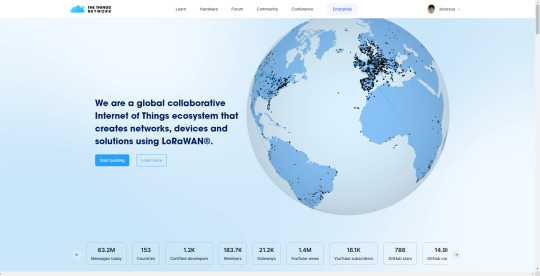
Ver no WordPress
#arduino lorawan#arduino lorawan library#esp32 lorawan#lorawan#lorawan application server#lorawan concentrator#lorawan devices#lorawan distance#lorawan gateway#lorawan network#lorawan the things network#the things network#the things network gateway#the things network map
0 notes
Text
How do you handle water meter reading using Lora (Raspberry Pi, Arduino, Lorawan, IoT)?
Install a LoRaWAN Gateway: Begin by setting up a LoRaWAN gateway. This gateway acts as a receiver for data transmitted by LoRaWAN devices and forwards it to the network server. It connects to the internet and communicates with LoRaWAN devices within its coverage area.
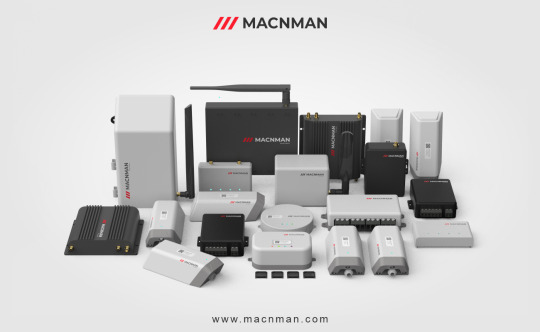
Attach LoRaWAN Modules to Water Meters: Next, equip your water meters with LoRaWAN modules or sensors. These modules are responsible for gathering important data, such as water consumption readings, from the meters.
Develop Firmware/Software: Program your Raspberry Pi or Arduino device to collect data from the water meters through the LoRaWAN modules. This programming may involve utilizing the LoRaWAN library or SDK provided by the module manufacturer.
Set Up a LoRaWAN Network Server: Install and configure a LoRaWAN network server. This server will receive and handle data from the water meters. Its functions include managing device registrations, routing messages, and storing data.
Ensure Secure Data Transmission and Encryption: Utilize LoRaWAN protocols to securely transmit the water meter readings from your Raspberry Pi or Arduino to the network server. LoRaWAN uses AES encryption to safeguard data privacy during transmission.
Data Processing and Storage: Once the network server receives the data, process it as needed. Extract the relevant water consumption readings and conduct any necessary calculations or validations. Store the data in a database or another suitable storage system.
Integration and Visualization: To make sense of the data, integrate it with your chosen IoT platform or application. This integration allows for further analysis and visualization. Consider creating a web-based dashboard or a mobile app to present the water consumption data in a user-friendly and informative manner.
It's important to keep in mind that the specific steps and details of implementation may vary based on the hardware and software components you select and any unique requirements associated with your water meter system. Adapt the above steps as necessary to align with your specific setup and development environment.
0 notes
Text
Hardware solutions for Eclipse IOT Challenge: Exploring LoRa/LoRaWAN
The Eclipse IOT challenge lead me to research more in depth different technologies both from the hardware and the software aspect. As part of product development and delivery one has to come up with the solution for a problem. In this case the problem is parking in urban areas, or the lack of smarter parking solutions. Such implementation would not only allow end users to have a better parking experience while saving time in finding an adequate spots but also provides the city with valuable data to be used for city planning and city improvement projects.
Once the issue is identified, it was important to find a technical solution that would align with our needs. For city implementations, given the broad area that needs to be covered, we would need a type of communication that is long range and low cost, both in cost of sending data and power consumption. I first tackled the hardware needs once the design was evaluated. The prototype for a smart city solution needs to also be scalable while adding the least overhead in cost and infrastructure needed.
In this article I will go more in depth on the research done to identify one of the key components of the project. I will share a summary of my findings in hopes of helping others that are also exploring similar solutions.
Evaluating communication solutions:
I evaluated BLE, bluetooth, cellular, satellite, Wi-Fi, SigFox, Zigbee and Lora. Bluetooth and Wi-Fi, given its range limitation and cost were not considered for this prototype. Cellular communications have a higher cost as well, and at even steeper price comes satellite communication; both this options were also discarded. SigFox and LoRa/LoraWAN were the runner up candidates. I came across a comprehensive post on the comparison of SigFox and LoRa that is worth the read https://www.link-labs.com/blog/sigfox-vs-lora . The winner was LoRa.
Why Lora?
As explained by Libelium on http://www.libelium.com/development/waspmote/documentation/lora-vs-lorawan/ LoRa contains only the link layer protocol and is perfect to be used in P2P communications between nodes. LoRa modules are a little cheaper that the LoRaWAN ones.. LoRaWAN includes the network layer too so it is possible to send the information to any Base Station already connected to a Cloud platform. LoRaWAN modules may work in different frequencies by just connecting the right antenna to its socket..
LoRa which stands for long range wireless operates at a low bandwidth, meaning that its best application is for sending smaller pieces of data such as sensor data. LoRaWAN is known for its good penetration and long coverage which has been recorded to reach over 10 KM distance. LoRaWAN operates on unlicensed bands, so in most countries is legal to have you own LoRaWAN gateway cutting down the cost given that you will not have to pay a carrier or third party to supply you with the service.
Additionally a selling point for me personally was the wide accessibility to various developer platforms and hardware solutions such as DIY LoRa kits, libraries and Arduino compatible LoRa modules. The Things Network offers a strong platform with access to resources, documentation and a great community of IOT LoRa enthusiast.

Gateway
Lets take a look at one of the hardware pieces now. “Gateways form the bridge between devices and The Things Network. Devices use low power networks like LoRaWAN to connect to the Gateway, while the Gateway uses high bandwidth networks like WiFi, Ethernet or Cellular to connect to The Things Network. Gateways are routers equipped with a LoRa concentrator, allowing them to receive LoRa packets”(see more at https://www.thethingsnetwork.org/docs/gateways/). Below is a list of some gateways that were evaluated for this project. I spent time looking at their platform flexibility, the documentation and support provided and what would be the most cost effective solution for a minimum viable product (MVP).
Lorixone
https://lorixone.io/
LORIX One is the first low cost gateway designed and assembled in Switzerland. Its technical specifications include Runx Linux Yocto 4.X SX1301 gateway chip SPI based 8 channels, 49 demodulators @ 868MHz
Lorixone counts with great documentation accessible at https://www.thethingsnetwork.org/labs/story/install-awesome-lorix-one-gateway

Kerlink
Details at https://www.kerlink.com/iot-solutions-services/IoT%20LoRaWan%20Solutions/
Wirnet iBTS is a range of modular and upgradeable gateways designed for IoT public operators. It can be upgraded up to 64 LoRa™ channels to offer an answer to massive messages supporting. I was unable to identify the price point for this gateway.
The Things Gateway
Details at https://www.thethingsnetwork.org/docs/gateways/gateway/
Retails: € 300.00 € 280.00 (ex VAT)
Originally started as a Kikstarter campaign viewable at https://www.kickstarter.com/projects/419277966/the-things-network it provides 10 km / 6 miles radius of network coverage, it can server thousands of nodes and its an straight forward to set up. It counts with ample documentation and a strong community.
Technical specifications:
Fastest way to get started with LoRaWAN (Long Range WAN)
Set up your own LoRaWAN network in as little as 5 minutes
Connects easily to your WiFi or Ethernet connection
Wireless range of up to 10 km (6 miles)
Engage with a global community of IoT developers
Easy cloud integration with popular IoT platforms
Based on open source hardware and software standards
Devices can freely communicate over all gateways connected to The Things Network
XBEE slot for future connectivity protocols or homebrew add-ons.
Security through the https connection and embedded in the LoRaWAN protocol
Can serve thousands of nodes (depending on traffic)

Laird — RG1xx
Details at: https://www.lairdtech.com/products/rg1xx-lora-gateway
Retail 400+ US dollars
This gateway counts with a dual-band Wi-Fi, BT v4.0 (BLE and Classic) and wired Ethernet; LoRa range up to 10 miles and pre-loaded LoRa Packet Forwarder software
Technical specifications:
Full Linux operating system — Kernel v4.x running on Atmel A5 Core @ 536 MHz
Multiple interfaces such as LoRaWAN, 802.11a/b/g/n, Bluetooth v4.0, and Ethernet
8-Channel LoRaWAN support with up to +27dBM max transmit power
Comprehensive Certifications for FCC / IC (RG191) and CE (RG186) (all pending)
Industrial temperature range (-30º to 70º C)
Advanced deployment tools including intuitive web-based configuration, integrated LoRa packet forwarder, and default settings for multiple LoRaWAN Network Server vendors
Enterprise-grade security built on Laird’s years of experience in wireless
Industry-leading support works directly with Laird engineers to help deploy your design
LoRa Network Server pre-sets — The Things Network, Loriot, Stream and Senet
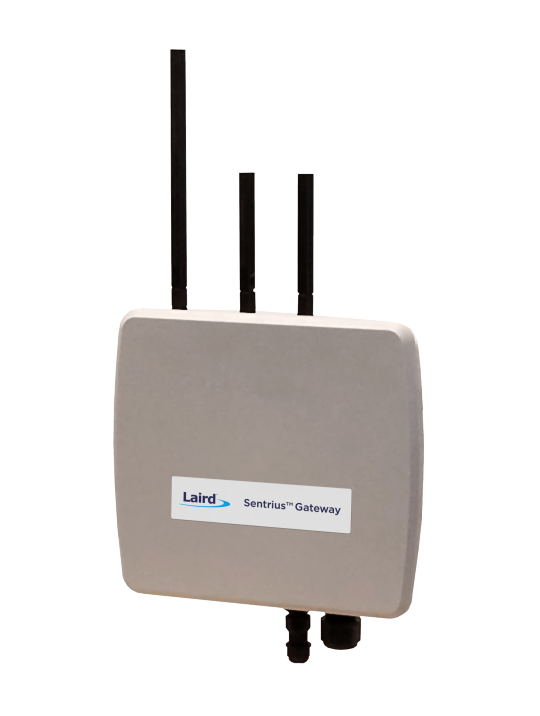
Multitech
Developer resource http://www.multitech.net/developer/products/multiconnect-conduit-platform/
Retail 675–685 US dollars
Breakdown: base gateway MTCDT-H5–210L-US-EU-GB https://www.digikey.com/product-detail/en/multi-tech-systems-inc/MTCDT-H5-210L-US-EU-GB/881-1236-ND/5246365() $490, antenna (https://www.digikey.com/product-detail/en/multi-tech-systems-inc/AN868-915A-10HRA/881-1242-ND/5246371) $13, LoRa module MTAC-LORA-915 (https://www.digikey.com/product-detail/en/multi-tech-systems-inc/MTAC-LORA-915/881-1239-ND/5246368) $180
The MultiConnect® Conduit™ is a configurable, scalable cellular communications gateway for industrial IoT applications. Conduit allows users to plug in two MultiConnect mCard™ accessory cards supporting wired or wireless interfaces. It counts with open source Linux development, wwo mcard slots, Lora 8 channel receiver, Spred spectrum frequency hopping that is ued to Up to 10 miles line of sight. MultiConnect has done a great job with its documentation and it counts with its own platform that can be used as well.

Lorrier LR2
Details at: https://lorrier.com/#introducing-lr2
Developer resource: https://github.com/lorriercom
Retail €615.00 €755.00
Based on LoRaWAN™ protocol. This is a fully outdoor device intended to establish a wide coverage network by telecommunications operators and local network by individuals or IoT connectivity service providers. The whole solution, including both HW and SW parts, follows the Lorrier culture, and it is shared as an Open Source.
The gateway is based on iC880a LoRaWAN™ concentrator by IMST which uses Semtech SX1301 base band processor designed for use with LoRa® networks. BeagleBone Green with 1GHz (2000 MIPS) processor and fully operational on fast SPI bus was chosen as a powerful control unit.

LoRa/LoRaWAN Gateway — 915MHz for Raspberry Pi 3
Details at https://www.seeedstudio.com/LoRa%2FLoRaWAN-Gateway-915MHz-for-Raspberry-Pi-3-p-2821.html
Retails 289.00 US dollars
If you want to build you own LoRa network, there are 3 things that you should prepare to get started: a Gateway, at least one Node and a local server where you can monitor all your devices. This kit provides a gateway & local server that allows you to collect and transfer data among all your LoRa nodes. By connecting the gateway with Seeeduino LoRaWAN and Grove modules, you can build your IOT prototype within minutes.
Regarding the gateway module RHF0M301, it is a 10 channel(8 x Multi-SF + 1 x Standard LoRa + 1 x FSK) LoRaWan gateway moduel with a 24pin DIP port on board, users can easily connect the RHF0M301 with PRI 2 bridge RHF4T002, adapter for Raspberry Pi 3 and RHF0M301.

RisingHF gateway
Details at http://www.risinghf.com/product/rhf0m301/?lang=en
I have seen this solution mentioned and used across the LoRaWAN community. Its technical specs are RHF0M301 is a 10 channels (8 x Multi-SF + 1 x Standard LoRa + 1 x FSK) LoRa/LoRaWAN gateway or concentrator module. The module is integrated one 24 pins DIP hearder, with this header user could connect RHF0M301 with his own embedded platform to build a customized gateway easily.
LG01 LoRa OpenWrt IoT Gateway by Dragino Tech
Details at https://www.tindie.com/products/edwin/lg01-lora-openwrt-iot-gateway/?pt=ac_prod_search
Retails 56.00 US dollars
This gateway is a long distance wireless 433/868/915Mhz, OpenWrt, LoRa IoT Gateway
The LG01 is an open source single channel LoRa Gateway. It lets you bridge LoRa wireless network to an IP network via WiFi, Ethernet, 3G or 4G cellular.
DYI options:
There are various posts on DYI options based both from Raspberry Pi and Arduino boards. Below are a few:
Build your own gateway
https://www.thethingsnetwork.org/docs/gateways/start/build.html
Building a Raspberry Pi Powered LoRaWAN Gateway
https://www.rs-online.com/designspark/building-a-raspberry-pi-powered-lorawan-gateway
Hardware IMST iC880A LoRaWAN “concentrator” board and Raspberry Pi
The iC880A — LoRaWAN https://wireless-solutions.de/products/long-range-radio/ic880a iC880A is able to receive packets of different end devices send with different spreading factors on up to 8 channels in parallel. In combination with an embedded Linux board like Raspberry Pi, Beagle Bone, Banana Pi and the HAL software from https://github.com/Lora-net a complete LoRaWAN® gateway can be setup easily.
From zero to LoRaWAN in a weekend
https://github.com/ttn-zh/ic880a-gateway/wiki
Based iC880a concentrator board and a Raspberry Pi 2.
A DIY low-cost LoRa gateway
http://cpham.perso.univ-pau.fr/LORA/RPIgateway.html
The gateway is based on a Raspberry PI. RPI 1B+/2B/3B can be used. The LoRa modules comes from (a) Libelium LoRa radio module, (b) HopeRF RFM92W/HopeRF RFM95W (or RFM96W for 433MHz), © Modtronix inAir9/inAir9B (or inAir4 for 433MHz), (d) NiceRF LoRa1276. Libelium LoRa and RFM92W use the Semtech SX1272 chip while RFM95W, inAir9/9B and NiceRF LoRa1276 use the SX1276 which is actually more versatile.
Note: The LoRa module and the LoRaWAN module are not compatible because the protocols are different. The LoRa module implements a simple link protocol, created by Libelium. However, the LoRaWAN module runs the LoRaWAN protocol, a much richer and more advanced protocol, created by the LoRa Alliance.
Check out their Github page with detailed documentation https://github.com/CongducPham/LowCostLoRaGw
Conclusion on gateways:
The gateway is a key portion of this solution given that the sensors will need to send the information “somewhere” where it can either be analyzed on the edge or sent to the cloud. After considering price ranges on both the parts needed for a DIY solution or a full blown gateway I considered those solutions that would be cost effective and which I was most familiar with. The “LG01 LoRa OpenWrt IoT Gateway by Dragino Tech” seemed the best approach. The developer kit counts with an Arduino developer node and a Developer gateway. Note that this solution only counts with ONE channel, in comparison with other solutions that allow 8+ channels. This was a compromise that was evaluated and given that this will be a prototype the one channel option seemed sufficient.
In the following articles I will showcase both the remaining hardware parts and the software portion along with updates on how the project is coming along.
17 notes
·
View notes
Photo
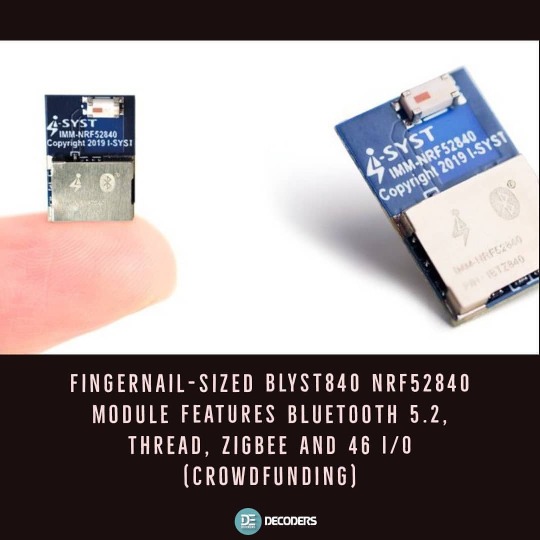
Canada based I-SYST inc has designed a tiny nRF52840 module about the size of a fingernail. BLYST840 module fully leverages the capability of Nordic Semi’s wireless microcontroller with Bluetooth 5.2, Thread, and Zigbee connectivity, and exposes 46 I/Os. BLYST840 specifications: Wireless MCU – Nordic Semiconductor nRF52840 Arm Cortex-M4F microcontroller @ 64 MHz with 1 MB flash, 256 KB RAM Connectivity Bluetooth 5.2 up to 2 Mbps, -96 dBm sensitivity for long-range; Up to 111 dB link budget; Bluetooth Mesh IEEE 802.15.4 radio support for Thread & Zigbee NFC-A Built-in ceramic antenna Output power – Adjustable from +8 dBm to -20 dBm 46 I/O pins exposed via pads around the edges of the module including QSPI/SPI/2-wire/I2S/PDM/QDEC Programmable Peripheral Interface (PPI) SPI interface @ 32 MHz Quad SPI interface @ 32 MHz EasyDMA for all digital interfaces USB 2.0 (12 Mbits) 12-bit/200K SPS ADC Security Arm TrustZone Cryptocell 310 128-bit AES/ECB/CCM/AAR co-processor Misc – Built-in 32 MHz & 32.768 MHz crystal Supply Voltage – 1.7 V to 5.5 V via battery or USB power. Dimensions – 14 x 9 x 1.6mm Certifications – FCC, IC & CE The module is programmable with MicroPython, IOsonata open-source multi-architecture multi-platform library for IoT project, as well as Nordic SDKs. You’ll find some documentation and firmware file on SourceForge. - - Source- CNX software - - ➖➖➖➖➖➖➖➖➖➖➖➖ Follow Us On: @decoders8421 Tag Your Friends 👼. Ask any query or doubt in comments. ➖➖➖➖➖➖➖➖➖➖➖➖ - #fpga #atmega #arm #nxp #embedded #iot #developmentboard #rpi #raspberrypi #arduino #arduinouno #raspberrypi3 #tinkercad #tinker #stm32 #esp32 #lorawan #lora #ai #ml #beagleboneai #raspberrypi4 #sbc #cortex #singleboard #singleboardcomputer #iot #zigbee #opencv #raspberrypicamera https://www.instagram.com/p/CBLtnTpHm-Q/?igshid=yket98i0uska
#fpga#atmega#arm#nxp#embedded#iot#developmentboard#rpi#raspberrypi#arduino#arduinouno#raspberrypi3#tinkercad#tinker#stm32#esp32#lorawan#lora#ai#ml#beagleboneai#raspberrypi4#sbc#cortex#singleboard#singleboardcomputer#zigbee#opencv#raspberrypicamera
0 notes
Text
Módulo LoRaWAN da Radioenge Tutorial Completo
O módulo LoRaWAN da Radioenge é homologado pela Anatel e 100% fabricado no Brasil e neste post você aprende tudo sobre ele.
O módulo LoRaWAN da Radioenge é uma placa de fabricação nacional e homologada que pode ser usada com qualquer microcontrolador ou microprocessador através de comandos AT via porta serial.
1 O que é LoRaWAN?
O LoRaWAN é um protocolo que desenvolvido para aumentar o alcance da rede LoRa e utiliza nós em estrela para diminuir ao máximo o consumo da bateria, de modo que os ‘end nodes’ fiquem…

Ver no WordPress
#arduino lorawan#arduino lorawan library#class a lorawan#esp32 lorawan#esp32 lorawan gateway#lorawan#lorawan board#lorawan concentrator#lorawan development kit#lorawan devices#lorawan esp32#lorawan examples#lorawan gateway#lorawan network
1 note
·
View note
Text
GPIOs do LoRaMesh da Radioenge: Portas digitais
Aprenda como usar as GPIOs do módulo LoRaMesh da Radioenge
As GPIOs do LoRaMesh da Radioenge possibilita que possamos fazer aplicações de automação com um uso reduzido de hardware, dedicando apenas ao circuito de chaveamento (se necessário) e de alimentação.
No total temos no LoRaMesh 8 GPIOs sendo todas configuráveis como entrada ou saída digital e duas como leitura analógica. Porém neste post vamos apenas abordar as portas digitais.
Por qual motivo…
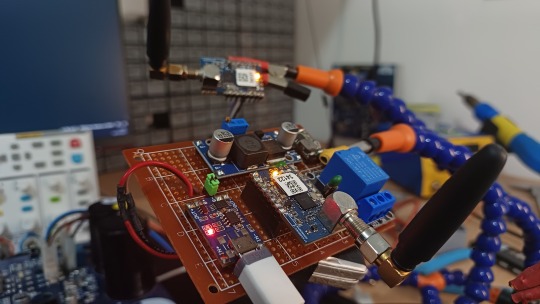
View On WordPress
#lora mesh arduino#lora mesh chat#lora mesh device#lora mesh library#lora mesh module#lora mesh network#lora mesh network raspberry pi#lora mesh protocol#lora mesh radio#lora mesh range#lora vs lorawan#loramesh#lorawan#lorawan devices#lorawan gateway#lorawan network#mesh lora
0 notes
Text
Leitura analógica do LoRaMesh da Radioenge
Aprenda como usar a leitura analógica com o módulo LoRaMesh da Radioenge
A leitura analógica com o LoRaMesh possibilita com que possamos fazer um amplo sistema de sensoriamento remoto sem precisar necessariamente de microcontrolador adicional na parte do slave.
Por qual motivo usar a leitura analógica do LoRaMesh da Radioenge?
Uma leitura digital em muito dos casos já é mais que o suficiente para saber se algo está ou não funcionando, mas a leitura analógica do…

View On WordPress
#lora mesh arduino#lora mesh chat#lora mesh device#lora mesh library#lora mesh module#lora mesh network#lora mesh network raspberry pi#lora mesh protocol#lora mesh radio#lora mesh range#lora vs lorawan#loramesh#lorawan#lorawan devices#lorawan gateway#lorawan network#mesh lora
0 notes